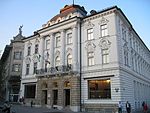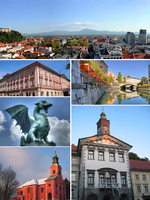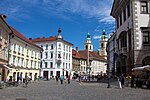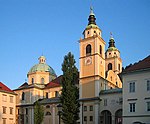Kresija Building
Center District, LjubljanaCultural venues in LjubljanaGovernment buildings completed in 1898Palaces in LjubljanaRenaissance Revival architecture in Ljubljana

The Kresija Building (Slovene: palača Kresija) is a building that together with Philip Mansion marks the entrance to the old town of Ljubljana, the capital of Slovenia. It stands at the Adamič and Lunder Embankment (Adamič-Lundrovo nabrežje) on the right bank of the river Ljubljanica immediately after the Triple Bridge and borders Pogačar Square (Pogačarjev trg), Stritar Street (Stritarjeva ulica), and Maček Street (Mačkova ulica). Until 2007, the Ljubljana Center Administrative Unit was stationed in the building. Now, it houses a number of municipal offices, the Kresija Gallery, and the Ljubljana visitor centre.
Excerpt from the Wikipedia article Kresija Building (License: CC BY-SA 3.0, Authors, Images).Kresija Building
Adamič-Lundrovo nabrežje, Ljubljana Trnovo
Geographical coordinates (GPS) Address Nearby Places Show on map
Geographical coordinates (GPS)
| Latitude | Longitude |
|---|---|
| N 46.051011111111 ° | E 14.506811111111 ° |
Address
Adamič-Lundrovo nabrežje
Adamič-Lundrovo nabrežje
Ljubljana, Trnovo
Slovenia
Open on Google Maps









